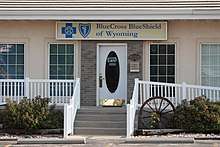Blue Cross Blue Shield Association
Blue Cross Blue Shield Association (BCBSA) is a federation of 36 separate United States health insurance companies that provide health insurance in the United States to more than 106 million people.[2] It was formed in 1982 from the merger of its two namesake organizations: Blue Cross was founded in 1929 and became the Blue Cross Association in 1960, while Blue Shield emerged in 1939 and the Blue Shield Association was created in 1948.
 | |
 | |
| Founded | 1929 |
|---|---|
| 13-5656874[1] | |
| Legal status | 501(c)(4) public welfare organization[1] |
| Location |
|
| Coordinates | 41.8864516°N 87.6239771°W |
| Products | Health insurance PPOs and HMOs |
Interim Chief Executive Officer | David Lesar[1] |
| Subsidiaries | Health Services Foundation, BC and BS Foundation on Health Care, BCBSA Services Inc[1] |
Revenue (2014) | $457,383,677[1] |
| Expenses (2014) | $449,635,361[1] |
Employees (2014) | 1,253[1] |
| Website | www |
In the healthcare insurance industry, the organization is known as "The Association" and has two offices: in Chicago and Washington, D.C. The main office is in Chicago in the Illinois Center at 225 North Michigan Avenue. The BCBSA claims to control access to the Blue Cross and Blue Shield trademarks and names across the United States and in more than 170 other countries, which it then licenses to the affiliated companies for specific, exclusive geographic service areas.[3] It has affiliated plans in all 50 states, the District of Columbia, and Puerto Rico, as well as licensees offering plans in several foreign countries; it also operates a nationwide health insurance program for employees of the United States federal government.[4] The BCBSA manages communications between its members and the operating policies required to be a licensee of the trademarks. This permits each BCBSA company to offer nationwide insurance coverage even though it operates only in its designated service area.[3]
History
Blue Cross and Blue Shield developed separately, with Blue Cross providing coverage for hospital services and Blue Shield covering physicians' services.[5]
Blue Cross is a name used by an association of health insurance plans throughout the United States. Its predecessor was developed by Justin Ford Kimball in 1929, while he was vice president of Baylor University's health care facilities in Dallas, Texas.[6] The first plan guaranteed teachers 21 days of hospital care for $6 a year, and was later extended to other employee groups in Dallas, and then nationally.[6] The American Hospital Association (AHA) adopted the Blue Cross symbol in 1939 as the emblem for plans meeting certain standards. In 1960, the AHA commission was superseded by the Blue Cross Association. Blue Cross severed its ties with the AHA in 1972.
Blue Shield was developed by employers in lumber and mining camps of the Pacific Northwest to provide medical care by paying monthly fees to medical service bureaus composed of groups of physicians.[7][8] In 1939, the first official Blue Shield plan was founded in California. In 1948, the symbol was informally adopted by nine plans called the Associated Medical Care Plan, and was later renamed the National Association of Blue Shield Plans.
In the 1960s the U.S. government chose to partner with Blue Cross and Blue Shield companies to administer Medicare.[8]
In 1982, Blue Shield merged with The Blue Cross Association to form the Blue Cross and Blue Shield Association (BCBS).[9]
Prior to 1986, organizations administering BCBS were tax exempt under 501(c)(4) as social welfare plans. However, the Tax Reform Act of 1986 revoked the exemption, because the plans sold commercial-type insurance. They became 501(m) organizations, subject to federal taxation, but entitled to "special tax benefits"[10] under IRC 833.[11]
In 1994, BCBS changed to allow its licensees to be for-profit corporations.[5] During 2010, Health Care Service Corporation, the parent company of BCBS in Texas, Oklahoma, New Mexico, Montana and Illinois, nearly doubled its income to $1.09 billion in 2010, and began four years of billion-dollar profits.[12] In the final spending bill for FY 2015 after much lobbying since 2010, nonprofit Blue Cross and Blue Shield plans continue to have special tax breaks that were understood to be threatened by the Affordable Care Act of 2010.[13]
Current organization
Blue Cross and Blue Shield insurance companies are licensees, independent of the association and traditionally of each other, offering insurance plans within defined regions under one or both of the association's brands. Blue Cross Blue Shield insurers offer some form of health insurance coverage in every U.S. state. They also act as administrators of Medicare in many states or regions of the U.S.[14]
The Blue Cross Blue Shield Federal Employee Program (FEP) is a nationwide option under the Federal Employees Health Benefits Program (FEHB) for U.S. federal government employees and retirees, and has been part of FEHB since FEHB's inception in 1960.[15] FEP enrolls over half of the federal workforce, with over 5 million members, making it the largest insurer of federal employees and the largest single health plan group in the world.[3][15][16][17]
The association has its headquarters in the Michigan Plaza complex in the Chicago Loop area of Chicago, Illinois.[18]
Member companies

|
Publicly traded companies
Multi-state private companies
|
Single-state or regional companies
Companies outside of the United States
|
Details on specific organizations
Idaho
Blue Cross of Idaho and Regence[21] Blue Shield of Idaho are separate companies and compete throughout the state.
Regence Blue Shield of Idaho announced a strategic alliance (not a merger) with Blue Cross North Carolina.[22]
Pennsylvania
Though historically "Blue Cross" was used for hospital coverage while "Blue Shield" was used for medical coverage,[23] today that split only exists for traditional health insurance plans in Pennsylvania. Two independent companies operate in central Pennsylvania, Highmark Blue Shield (Pittsburgh) and Capital Blue Cross (Central Pennsylvania) . In southeastern Pennsylvania, Independence Blue Cross (Philadelphia) has a joint marketing agreement with Highmark Blue Shield (Pittsburgh) for their separate hospital and medical plans. However, Independence Blue Cross, like most of its sister Blue Cross-Blue Shield companies, cover most of their customers under managed care plans such as HMOs and PPOs which provide hospital and medical care in one policy.
Nonprofit status debate
While only some members retain nonprofit status, the ones that do have been criticized for holding excessive amounts of cash or excessive executive compensation. In 2014, BC/BS of Illinois (Health Care Service Corporation) was sued over its nonprofit status, with the lawsuit dismissed with prejudice and the ruling upheld on appeal.[24] Similar suits occurred with similar results in other states such as Oregon.[25]
For-profit conversions
Conversions into for-profit corporations typically results in distribution of some of the assets into a charitable foundation. When Blue Cross of California was converted, it initially had no distribution, but subsequently The California Endowment and California Health Care Foundation were endowed with $3.2b.[26] Proceeds ranged from $3.2b (California) to $1.5m (Nevada).[27]:63
An exceptional case occurred in the Empire Blue Cross conversion, where the proceeds went to fund wage increases for union workers.[28]
See also
References
- "Form 990: Return of Organization Exempt from Income Tax". Blue Cross and Blue Shield Association. Guidestar. December 31, 2014.
- "Blue Cross Blue Shield Association - Supporting the 36 Independent, Locally Operated Blue Cross and Blue Shield Companies - BCBS.com". bcbs.com. Archived from the original on 2011-11-05. Retrieved 2011-11-02.
- "The Blue Cross Blue Shield System | Blue Cross Blue Shield". www.bcbs.com. Retrieved 2019-12-11.
- "BCBS® Companies and Licensees | Blue Cross Blue Shield". www.bcbs.com. Retrieved 2019-12-11.
- Coordinated Issue Paper – Blue Cross Blue Shield/Health Insurance; Life Insurance: Conversion of nonprofit corporations. 4 June 2008) Archived 6 May 2009 at the Wayback Machine
- Justin Ford Kimball from the Handbook of Texas Online. Retrieved August 31, 2009.
- "Health Care Service Corporation (HCSC) – Who We Are". www.hcsc.com. Archived from the original on 2016-11-08. Retrieved 2017-01-06.
- Marc Lichtenstein (n.d.). "Health Insurance From Invention to Innovation: A History of the Blue Cross and Blue Shield Companies". Blue Cross and Blue Shield Association. Archived from the original on 2014-05-23. Retrieved 2014-05-23.
- "History of Blue Cross and Blue Shield Association – 1980s". Blue Cross and Blue Shield Association. Archived from the original on September 26, 2009.
- "Nonprofit Health Inc.: Overview of issues in the protection of nonprofit assets - Blue Cross: 501(m)". Consumers Union. 1 January 2008. Retrieved 18 December 2014.
As of January 1, 1987, the federal government removed the full tax-exempt status of BCBS plans and instead created a special tax class for BCBS organizations, Internal Revenue Code ("I.R.C.") 5833. That I.R.C. category subjected BCBS plans to federal taxation but recognized the unique role BCBS plans play, unlike commercial for-profit insurers, and entitled it to special tax benefits.
- 26 USC § 833 – Treatment of Blue Cross and Blue Shield organizations, etc. | Title 26 – Internal Revenue Code | U.S. Code | LII / Legal Information Institute law.cornell.edu. Retrieved on 2013-09-05.
- "Blue Cross parent boosts profit in second quarter". Crain's Chicago Business. Crain Communication, Inc. 3 September 2013. Retrieved 18 December 2014.
- Pear, Robert (December 14, 2014). "In Final Spending Bill, Salty Food and Belching Cows Are Winners". The New York Times. Retrieved December 18, 2014.
- Health Insurance Facts | Smarter Consumers of Healthcare. Health Harbor. Retrieved on 2013-09-05.
- "Blue Cross and Blue Shield's Federal Employee Plan". FEP Blue. Retrieved 2019-12-11.
- "Feds Are Flocking to the Same Few Health Care Plans Despite Choices". Government Executive. Retrieved 2019-12-11.
GAO said since 2000, Blue Cross Blue Shield has become a behemoth in the federal employee insurance market. The company was the largest carrier in 93 percent of counties in 2000, and that proportion grew to 98 percent in 2015. Over that same time period, Blue Cross Blue Shield grew its median county market share from 58 percent to 72 percent.
- United States Government Accountability Office (2017). FEDERAL EMPLOYEES HEALTH BENEFITS PROGRAM: Enrollment Remains Concentrated Despite More Plan Offerings, and Effects of Adding Plan Types Are Uncertain. United States Government Accountability Office. p. 35.
BCBSA’s large program market share—66 percent of total program enrollment in 2015
- "Contact Us". Blue Cross and Blue Shield Association. Archived from the original on January 10, 2007. Retrieved December 23, 2009.
- "Contact Us". anthem.com. Retrieved 6 September 2016.
- "Florida Blue – New Name of BlueCross and BlueShield of Florida" (Press release). PRNewswire. April 2, 2012. Retrieved April 27, 2012.
- The Regence Group
- "Cambia health solutions announces strategic" (PDF). www.bizjournals.com. March 12, 2019. Retrieved 2019-06-05.
- "Blue Cross and Blue Shield, A Historical Compilation" (PDF). Consumer Union.
- Holland, Scott. "Appeals panel upholds dismissal of class action challenge of how Blue Cross parent corp uses profits". cookcountyrecord.com. Retrieved 2019-06-15.
- "Judge Dismisses Attempted Class-Action Suit Against Regence BlueCross BlueShield of Oregon | The Lund Report". www.thelundreport.org. Retrieved 2019-06-15.
- "Conversion and Preservation of Charitable Assets of Blue Cross and Blue Shield Plans: How States Have Protected or Failed to Protect the Public Interest" (PDF). Community Catalyst. Archived (PDF) from the original on 2016-12-09.
- "Blue Cross and Blue Shield A Historical Compilation" (PDF). Archived (PDF) from the original on 2019-04-12.
- Robinson, James C. (2003-07-01). "The Curious Conversion Of Empire Blue Cross". Health Affairs. 22 (4): 100–118. doi:10.1377/hlthaff.22.4.100. ISSN 0278-2715.
External links
![]()